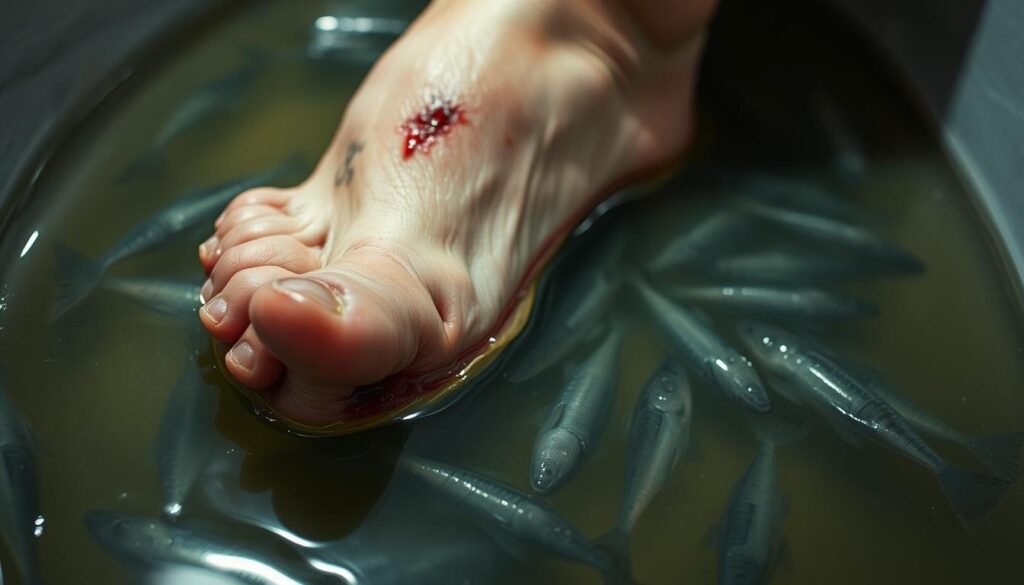Is Fish Pedicure Banned in Canada? Have you heard about the fish pedicure? It’s a spa treatment where small fish eat dead skin off your feet.
Many people are worried about its safety. This has led to questions about if it’s legal.
In this article, we’ll look into if you can get a fish pedicure in Canada. We’ll also talk about why it’s legal or not under Canada fish pedicure law.
By exploring this topic, you’ll learn about the rules around fish pedicure. You’ll also understand the impact of the fish pedicure ban in some places.
Contents
- 1 What Is a Fish Pedicure?
- 2 Is Fish Pedicure Banned in Canada?
- 3 Reasons Behind the Canadian Fish Pedicure Ban
- 4 Health and Safety Risks of Fish Pedicures
- 5 Alternative Foot Treatments Available in Canada
- 6 Conclusion: Is Fish Pedicure Banned in Canada
- 7 FAQ
- 7.1 What is the current legal status of fish pedicures in Canada?
- 7.2 Why are fish pedicures considered a health risk?
- 7.3 What are Garra rufa fish, and what role do they play in fish pedicures?
- 7.4 Are there any alternative foot treatments available in Canada?
- 7.5 Can I get a fish pedicure in the United States and then travel to Canada?
- 7.6 How can I maintain good foot hygiene without getting a fish pedicure?
- 7.7 Are there any health benefits associated with fish pedicures?
What Is a Fish Pedicure?
A fish pedicure is a spa treatment where you soak your feet in water with small fish. These fish, like Garra rufa or Cyprinion macrostomus, eat the dead skin off your feet.
This treatment happens in a special foot spa. First, your feet get cleaned to remove dirt and bacteria. Then, they’re placed in a tank with the fish. The fish eating the dead skin might feel tickly, but it’s often seen as calming.
The benefits of a fish pedicure include:
- Smoothening of the skin on your feet by removing dead skin cells.
- A unique, relaxing experience that some people find therapeutic.
- Potential reduction in the appearance of rough patches or calluses.
Fish pedicures started in Turkey and Asia and became popular worldwide. They’re a unique way to care for your feet, different from regular treatments.
Is Fish Pedicure Banned in Canada?
Thinking about getting a fish pedicure in Canada? You might be wondering if it’s legal. The answer depends on the province and the situation.
In Canada, health authorities in each province control fish pedicures. Some provinces have banned them because of health risks. Others have strict rules to keep things safe.
To find out if fish pedicures are legal in Canada, let’s look at the rules in different provinces. Here’s a table showing the status of fish pedicure regulations in various provinces:
| Province | Status of Fish Pedicure | Reason for Regulation |
|---|---|---|
| Ontario | Banned | Health and safety concerns |
| British Columbia | Regulated | Guidelines for safe practice |
| Alberta | Banned | Risk of infection |
From the table, we see that some provinces like Ontario and Alberta ban fish pedicures. But British Columbia regulates them. This means the rules for fish pedicures vary across Canada.
To get the latest info, check with the health authority in your province. They can tell you about the current laws and rules for fish pedicures.
Reasons Behind the Canadian Fish Pedicure Ban
Health concerns were key in the Canadian government’s ban on fish pedicures. The main worries are the risks linked to this treatment.
Health Concerns
The health risks of fish pedicures are many. They include:
- The risk of infection from the fish or contaminated water
- Allergic reactions to the fish or the water used in the pedicure tanks
- The potential for the spread of diseases between clients using the same fish
These risks are serious. The fish, often Garra rufa, can carry harmful bacteria. You might be at risk if you have open wounds or a weak immune system.
Also, the well-being of the fish is a big concern. The conditions they live in can be stressful, leading to health problems.
The Canadian authorities looked at these points when they banned fish pedicures. By knowing the reasons behind the ban, you see how important health and safety are in spa treatments.
Some main reasons for the ban are:
- Lack of effective regulation and monitoring of fish pedicure facilities
- Insufficient evidence on the long-term health impacts of fish pedicures
- The potential for fish to be carriers of infection
Health and Safety Risks of Fish Pedicures
Fish pedicures might seem interesting, but they come with health and safety concerns. You put your feet in a tank with fish that eat dead skin. But, this can be risky for your health.
One big worry is getting an infection. The fish in these pedicures might carry harmful bacteria. If the tank water isn’t clean, these germs can spread, putting you at risk. Infection control is very important here.
Infection Control
Keeping fish pedicure tanks clean is hard. The tanks need regular cleaning and the fish must be healthy. But, it’s tough to keep everything clean, especially if places don’t follow good hygiene rules.
Some dangers of fish pedicures include:
- Bacterial infections like Staphylococcus or Pseudomonas from dirty water or fish.
- Viral infections, like hepatitis, if the water isn’t cleaned well between clients.
- Fungal infections, which can grow in the wet environment of the tank.

To avoid these risks, salons must follow strict cleaning rules. They should also keep the fish healthy and check clients for any wounds or infections before the pedicure.
Before getting a fish pedicure, knowing the risks can help you decide. It’s also key to pick a salon that focuses on cleanliness and safety.
Alternative Foot Treatments Available in Canada
In Canada, you can find many safe and new foot treatments. These options go beyond the risks of fish pedicures. You can choose from traditional spa treatments and modern innovations for your foot care.
- Traditional pedicures with a focus on hygiene and safety
- Reflexology treatments that stimulate pressure points
- Foot massages to relieve tension and improve circulation
- Advanced nail care treatments, including gel and acrylic applications
These treatments offer relaxation and help with foot health issues. For example, reflexology can ease pain and boost well-being.
| Treatment | Benefits | Average Duration |
|---|---|---|
| Traditional Pedicure | Hygiene, nail care, relaxation | 30 minutes |
| Reflexology | Pain relief, improved circulation | 45 minutes |
| Foot Massage | Tension relief, relaxation | 30-60 minutes |
When picking a foot treatment, think about what you need and like. Many spas in Canada offer special packages. These packages mix different treatments for a full foot care experience.
Conclusion: Is Fish Pedicure Banned in Canada
You now know the laws about fish pedicures in Canada. You also understand the health risks they pose.
Many provinces in Canada have banned fish pedicures. This is because of concerns over hygiene and safety.
Looking for other foot treatments? Canada has many options. You can choose from traditional pedicures to reflexology.
Knowing the laws and risks helps you make better choices. It ensures your health and safety when choosing spa treatments.
See Also: Utah’s Flavored Nicotine Ban: What’s the Latest?
FAQ
What is the current legal status of fish pedicures in Canada?
Fish pedicures are banned in Canada. This is due to health and safety concerns.
Why are fish pedicures considered a health risk?
Fish pedicures are seen as a health risk. They can spread infections through the water or the fish. Keeping the area clean is hard.
What are Garra rufa fish, and what role do they play in fish pedicures?
Garra rufa fish are small fish used in fish pedicures. They eat dead skin cells on your feet.
Are there any alternative foot treatments available in Canada?
Yes, Canada offers many foot treatments. You can try traditional pedicures or new spa treatments. These options are safer than fish pedicures.
Can I get a fish pedicure in the United States and then travel to Canada?
You can get a fish pedicure in the United States. But, it’s not wise to do so before visiting Canada. You might still get sick, and Canadian health officials might worry about the risks.
How can I maintain good foot hygiene without getting a fish pedicure?
To keep your feet clean, wash them often. Trim your toenails and use a pumice stone or foot file. These steps help remove dead skin cells.
Are there any health benefits associated with fish pedicures?
Some say fish pedicures can soften and smooth your feet’ skin. But, not everyone agrees. The risks often seem greater than any benefits.

Marcellus Stark is an investigative journalist from San Francisco, USA. He writes about global bans, rules, and unusual laws. He shares clear, interesting, and well-researched stories that help readers understand surprising facts worldwide.

